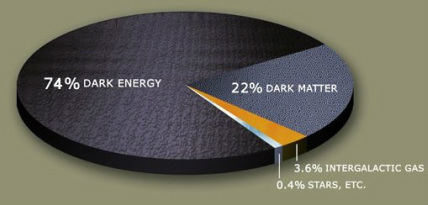3.5: Dark Matter and Dark Energy
- Page ID
- 12776
 The Big Bang theory is still the best scientific model we have for explaining the formation of the universe and many lines of evidence support it. However, recent discoveries continue to shake up our understanding of the universe. Astronomers and other scientists are now wrestling with some unanswered questions about what the universe is made of and why it is expanding. A lot of what cosmologists do is create mathematical models and computer simulations to account for these unknown phenomena, such as dark energy and dark matter.
The Big Bang theory is still the best scientific model we have for explaining the formation of the universe and many lines of evidence support it. However, recent discoveries continue to shake up our understanding of the universe. Astronomers and other scientists are now wrestling with some unanswered questions about what the universe is made of and why it is expanding. A lot of what cosmologists do is create mathematical models and computer simulations to account for these unknown phenomena, such as dark energy and dark matter.
Dark Matter
The things we observe in space are objects that emit some type of electromagnetic radiation. However, scientists think that matter that emits light makes up only a small part of the matter in the universe. The rest of the matter, about 80 percent, is dark matter. Dark matter emits no electromagnetic radiation so we can’t observe it directly. However, astronomers know that dark matter exists because its gravity affects the motion of objects around it. When astronomers measure how spiral galaxies rotate, they find that the outside edges of a galaxy rotate at the same speed as parts closer to the center. This can only be explained if there is a lot more matter in the galaxy than they can see.Gravitational lensing occurs when light is bent from a very distant bright source around a super-massive object. To explain strong gravitational lensing, more matter than is observed must be present. With so little to go on, astronomers don’t really know much about the nature of dark matter. One possibility is that it could just be ordinary matter that does not emit radiation in objects such as black holes, neutron stars, and brown dwarfs, objects larger than Jupiter but smaller than the smallest stars. But astronomers cannot find enough of these types of objects, which they have named MACHOS (massive astrophysical compact halo object), to account for all the dark matter, so they are thought to be only a small part of the total.Another possibility is that the dark matter is thought to be much different from the ordinary matter we see. Some appear to be particles that have gravity, but don’t otherwise appear to interact with other particles. Scientists call these theoretical particles WIMPs, which stands for Weakly Interactive Massive Particles.
Most scientists who study dark matter think that the dark matter in the universe is a combination of MACHOS and some type of exotic matter such as WIMPs. Researching dark matter is an active area of scientific research, and astronomers’ knowledge about dark matter is changing rapidly.
Dark Energy
Astronomers who study the expansion of the universe are interested in knowing the rate of that expansion. Is the rate fast enough to overcome the attractive pull of gravity?
- If yes, then the universe will expand forever, although the expansion will slow down over time.
- If no, then the universe would someday start to contract, and eventually get squeezed together in a big crunch, the opposite of the Big Bang.
Recently astronomers have made a discovery that answers that question: the rate at which the universe is expanding is actually increasing. In other words, the universe is expanding faster now than ever before, and in the future it will expand even faster. So now astronomers think that the universe will keep expanding forever. But it also proposes a perplexing new question: What is causing the expansion of the universe to accelerate? One possible hypothesis involves a new, hypothetical form of energy called dark energy. Some scientists think that dark energy makes up as much as 72 percent of the total energy content of the universe.
- Dynamic Earth: Introduction to Physical Geography. Authored by: R. Adam Dastrup. Located at: http://www.opengeography.org/physical-geography.html. Project: Open Geography Education. License: CC BY-SA: Attribution-ShareAlike
- Dark Matter 3D Map. Authored by: rshida. Located at: https://youtu.be/gCgTJ6ID6ZA. License: All Rights Reserved. License Terms: Standard YouTube License
- Shedding light on dark matter . Authored by: Patricia Burchat. Provided by: TED-Ed. Located at: https://youtu.be/bZW_B9CC-gI. License: All Rights Reserved. License Terms: Standard YouTube License
- Estimated distribution of dark matter and dark energy in the universe. Provided by: NASA. Located at: http://www.nasa.gov/vision/universe/starsgalaxies/Collision_Feature.html. License: Public Domain: No Known Copyright



